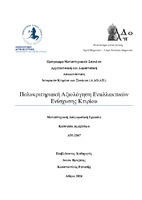| dc.contributor.advisor | Vryzidis, Isaak | |
| dc.contributor.advisor | Repapis, Constantinos | |
| dc.contributor.author | Κατσιάδα, Αλεξάνδρα | |
| dc.date.accessioned | 2024-04-12T08:43:37Z | |
| dc.date.available | 2024-04-12T08:43:37Z | |
| dc.date.issued | 2024-04-11 | |
| dc.identifier.uri | https://polynoe.lib.uniwa.gr/xmlui/handle/11400/6474 | |
| dc.identifier.uri | http://dx.doi.org/10.26265/polynoe-6310 | |
| dc.description.abstract | Τα τελευταία χρόνια εξαιτίας της πολυπλοκότητας στη λήψη αποφάσεων για τον ανασχεδιασμό των κτιρίων, έχουν αναπτυχθεί διάφορες μεθοδολογίες, κάποιες από τις οποίες βασίζονται στην πολυκριτήρια ανάλυση αποφάσεων. Η βιβλιογραφική ανασκόπηση ανέδειξε την εφαρμογή πλήθους μεθόδων πολυκριτήριας ανάλυσης στον ανασχεδιασμό κτιρίων. Η παρούσα εργασία πραγματεύεται το ζήτημα αξιολόγησης της ενίσχυσης και αποκατάστασης ενός κτιρίου τριών επιπέδων στην περιοχή της Αττικής, μέσω της χρήσης του στατικού προγράμματος Seismobuild. Πιο συγκεκριμένα θα προταθούν τρεις διαφορετικές εναλλακτικές ενίσχυσης όπως η περίπτωση χρήση μανδυών, FRPs και ο συνδυασμός μανδυών με τοιχώματα. Όπου μετά μέσω της πολυκριτήριας ανάλυσης και πιο συγκεκριμένα της μεθόδου ΤOPSIS αλλά και της εκτίμησης των βαρών με την μέθοδο WAP, των έξι κριτηρίων που λαμβάνονται υπόψη στην αξιολόγηση, θα αποφανθεί πια εναλλακτική ενίσχυσης είναι η καλύτερη επιλογή για το κτίριο. Τα κριτήρια είναι η τέμνουσα βάσης, ο χρόνος αποκατάστασης και ενίσχυσης κτιρίου, το κόστος κατασκευής, το περιβαλλοντικό αποτύπωμα άνθρακα, οι τεχνολογικές απαιτήσεις-βαθμός αναγκαιότητας εξειδίκευσης προσωπικού και τέλος ο βαθμός αρχιτεκτονικής επιρροής. Η συγκεκριμένη διπλωματική επιβεβαίωσε την χρησιμότητα της πολυκριτήριας ανάλυσης αποφάσεων στην βελτίωση της διαδικασίας επιλογής και στην αξιολόγηση των εναλλακτικών ενίσχυσης και αποκατάστασης κτιρίων. | el |
| dc.format.extent | 90 | el |
| dc.language.iso | el | el |
| dc.publisher | Πανεπιστήμιο Δυτικής Αττικής | el |
| dc.rights | Αναφορά Δημιουργού - Μη Εμπορική Χρήση - Παρόμοια Διανομή 4.0 Διεθνές | * |
| dc.rights | Attribution-NonCommercial-NoDerivatives 4.0 Διεθνές | * |
| dc.rights | Attribution-NonCommercial-NoDerivatives 4.0 Διεθνές | * |
| dc.rights | Attribution-NonCommercial-NoDerivatives 4.0 Διεθνές | * |
| dc.rights.uri | http://creativecommons.org/licenses/by-nc-nd/4.0/ | * |
| dc.subject | Βιωσιμότητα | el |
| dc.subject | Πολυκριτηριακή αξιολόγηση | el |
| dc.subject | WAP | el |
| dc.subject | TOPSIS | el |
| dc.subject | Μέθοδος Pushover | el |
| dc.subject | Eναλλακτικές λύσεις ενίσχυσης | el |
| dc.subject | Ενισχύσεις κτιρίων | el |
| dc.title | Πολυκριτηριακή αξιολόγηση εναλλακτικών ενίσχυσης κτιρίου | el |
| dc.title.alternative | Multi-criteria evaluation of building reinforcement alternatives | el |
| dc.type | Μεταπτυχιακή διπλωματική εργασία | el |
| dc.contributor.committee | Pnevmatikos, Nikos | |
| dc.contributor.faculty | Σχολή Μηχανικών | el |
| dc.contributor.department | Τμήμα Πολιτικών Μηχανικών | el |
| dc.contributor.master | Αρχιτεκτονική και Δομοστατική Αποκατάσταση Ιστορικών Κτιρίων και Συνόλων | el |
| dc.description.abstracttranslated | Ιn recent years due to the complexity in decision making for building redesign, various methods have been developed, some which are based on multi criteria decision analysis. The literature review highlights the application of several multi-criteria analysis methods in the design of buildings, in case they need to improve their seismic resilience. Various alternatives for building retrofitting exist, and each outweighs a set of parameters compared to the others. This study aims to evaluate alternatives in seismic retrofitting existing three-story building in Attica, using the program Seismobuild for seismic assessment and strengthening. More specifically, it will be proposed to use jacket on the existing columns and beams, FRPs just like the previous alternative, as well as the combination of using jackets and adding walls to provide increased support. The proposed methodology is based on the TOPSIS method, while the criteria weights are estimated with the WAP method. The criteria are the base shear, the building restoration and reinforcement time, the construction cost, the carbon footprint, the technological requirements-degree of necessity of personnel specialization and finally the degree of architectural influence. This dissertation confirmed the usefulness of multi-criteria decision analysis in improving the selection process and in the evaluation of the seismic retrofitting alternatives in existing buildings. | el |


